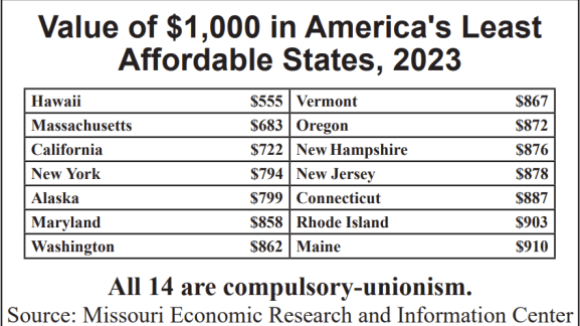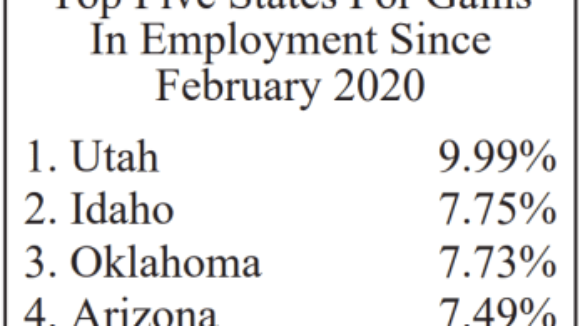Banning Compulsory Dues Curbs Cost of Living
On average, forced-unionism states are 23.2% more expensive to live in than Right to Work states. And decades of academic research show that compulsory unionism actually fosters a higher cost of living.
Michigan citizens are now seeing and hearing former Detroit news anchor Bill Bonds, most recently known as a pitchman for personal-injury lawyer Sam Bernstein, featured in TV and radio ads for a mysterious outfit known as “Wrong for Michigan.” “Wrong for Michigan” is in reality a front group for union officials.
In the ads, Bonds makes an ill-informed attack on current efforts to enact a state Right to Work law, which would simply prohibit the firing of employees for refusal to join or pay so-called “agency” fees to an unwanted union.
Bonds admits Michigan’s economy is abysmal, but claims that, were it not for the state’s pro-forced unionism policies, things would be even worse. But the only way forced unionism “solves” any of Michigan’s problems is by fostering such a terrible job market that young people are fleeing the state in droves. From 1996 to 2006 alone, the number of 25-34 year-olds in Michigan fell by 150,000, or 11%. And since young employees are disproportionately uninsured and apt to have accidents on the job, the exodus of its youth makes Michigan’s health-insurance and workplace safety statistics appear better than they really are. Is this the kind of “success” the union bosses who are bankrolling the “Wrong for Michigan” ads really want to brag about?
A fair reading of the evidence indicates that Michigan’s lack of a Right to Work law really constitutes a major part of what’s wrong with the state’s economy.
Over the past five years, the 22 Right to Work states’ aggregate private-sector job growth of 6.3% was more than five times greater than the 28 forced-dues states’ aggregate growth of just 1.2%. Looking at Michigan’s region of the country alone, the five Right to Work Midwestern states had a combined private-sector job growth of 2.6%, while the seven forced-unionism states suffered an overall decline of 0.8%. Michigan’s extraordinary loss of 5.3% of its private-sector jobs is thus plausibly a result of the extraordinary power of union officials in the Wolverine State. In Michigan, Big Labor wields “exclusive” (monopoly) power to bargain with employers over the wages, benefits, and work rules of a higher share of private-sector employees than in all but one other state in the continental U.S.
In addition to their misleading assertions about health insurance and job safety, the “Wrong for Michigan” ads ignore multiple scholarly studies showing that the presence of a Right to Work law is correlated with higher real earnings and disposable incomes. Even data furnished in the American Federation of Teachers (AFT/AFL-CIO) union’s “Survey and Analysis of Teacher Salary Trends 2002,” published in July 2003, show that on average living costs (excluding all taxes) are roughly 15% higher in non-Right to Work states than in Right to Work states.
Study after study that factors in cost-of-living differences shows that, on average, employees’ real earnings are higher in Right to Work states than in forced-unionism states. For example, a study using a cost-of-living index published by Congressional Quarterly found that the average cost of living-adjusted weekly earnings in Right to Work states in 2005 were $723, compared to $688 in non-Right to Work states.
There is also compelling evidence that state Right to Work laws benefit citizens at all income levels. In 2006, just 8.2 out of every 1000 residents of Right to Work states had to rely on federal welfare (TANF) to get by, compared to 17.2 out of every 1000 in non-Right to Work states as a group and 21.1 out of every 1000 in Michigan. In light of such data, it takes a lot of moxie for the union brass, using Bonds as their front man, to claim that forced unionism reduces poverty!
Union officials certainly have a right to oppose passage of a Right to Work law in Michigan. But no one has a right to resort to distortion and obfuscation.

On average, forced-unionism states are 23.2% more expensive to live in than Right to Work states. And decades of academic research show that compulsory unionism actually fosters a higher cost of living.

Strong employment gains in Right to Work states are the reason more Americans are working now than pre-COVID.

Worker effort prompted by Michigan Legislature’s Right to Work repeal, which subjects workers to pay-up-or-be-fired threats from UGSOA union